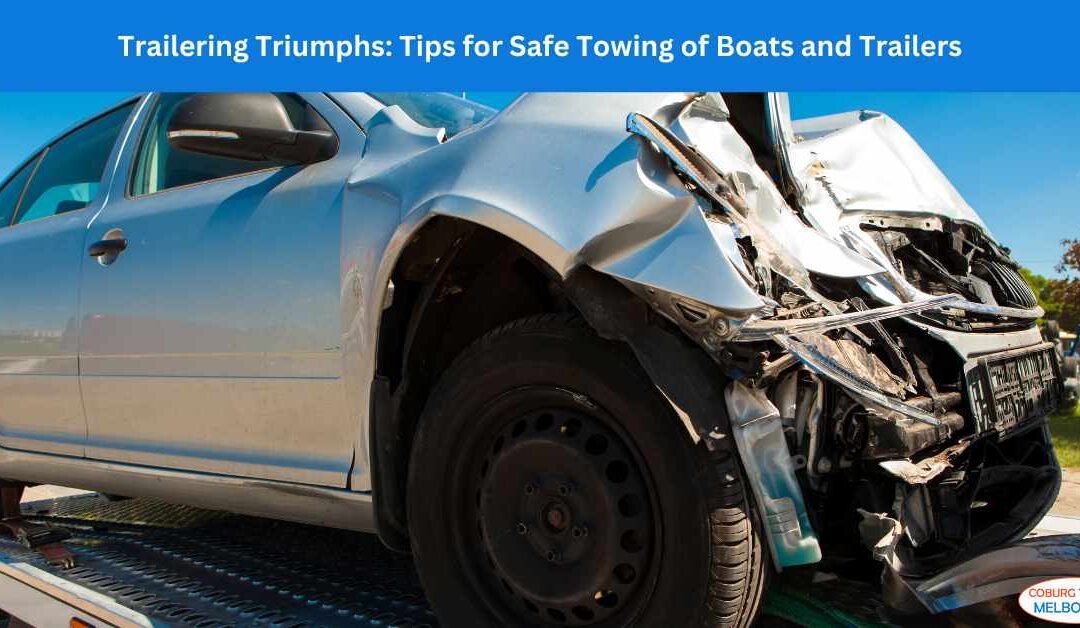Towing a boat or trailer offers freedom for adventurers, campers, and boaters, but it requires extra caution and skill to ensure safety on the road. Here’s a guide with essential tips for secure and successful towing, covering everything from preparation to the drive itself.
1. Choose the Right Vehicle and Trailer Match
Not all vehicles are suited to towing boats or heavy trailers. Check your vehicle’s tow rating to ensure it’s up to the task. The tow rating indicates the maximum weight your car can tow safely, so it’s essential to know your trailer’s weight (including cargo) and your vehicle’s capabilities.
Quick Tip: If you’re unsure about the tow rating, consult your vehicle’s manual or a professional. Overloading a vehicle can lead to dangerous handling and mechanical issues.
2. Use the Correct Hitch and Attachments
Selecting the proper hitch is crucial for safe towing. Make sure your hitch, ball mount, and other attachments are rated for your trailer’s weight. The hitch should fit snugly into your vehicle’s receiver, and safety chains should be connected securely.
Quick Tip: Cross the safety chains under the hitch in an “X” shape. This formation can prevent the trailer from dropping to the road if the hitch were to disconnect, offering an extra layer of safety.
3. Check Tire Pressure and Condition
Proper tire pressure is vital for both your vehicle and trailer. Underinflated tires can lead to swaying, while overinflated tires may reduce traction. Check the tires on both the tow vehicle and trailer to ensure they’re in good shape, with no cracks, punctures, or uneven tread wear.
Quick Tip: Carry a portable tire pressure gauge and air compressor for last-minute checks. Tires heat up during travel, so check and adjust the pressure before you start your journey.
4. Load Your Trailer Properly
Proper weight distribution is essential when loading a trailer. Heavier items should be loaded closer to the front (near the hitch) to maintain a balanced load, and the weight should be spread evenly from side to side to prevent swaying.
Quick Tip: Aim to have about 10-15% of the trailer’s total weight resting on the hitch. This weight distribution helps keep the trailer stable and reduces the risk of fishtailing.
5. Perform a Pre-Trip Safety Inspection
Before setting out, inspect your rig carefully. Check that lights (brake lights, turn signals, and taillights) on both the trailer and tow vehicle are working. Inspect the hitch connection, safety chains, and tires, and ensure that all cargo is secure.
Quick Tip: Walk around your vehicle and trailer to double-check every connection, ensuring nothing is overlooked. Having a checklist for each tow trip can help with this.
6. Practice Driving with a Trailer
Towing affects how a vehicle accelerates, turns, and stops. If you’re new to towing, practice in a wide-open space like a parking lot to get a feel for the extra weight. Practice turning, reversing, and stopping, keeping in mind that trailers take longer to respond to your actions.
Quick Tip: Remember that trailers have a larger turning radius than vehicles alone. Make wide turns to avoid curbs, poles, or other obstacles.
7. Maintain Safe Speeds and Increase Following Distance
Towing a trailer requires more time to stop and more space to maneuver. Drive slower than usual and keep a larger distance between you and the vehicle ahead to allow for gradual braking and handling.
Quick Tip: Avoid sudden lane changes or sharp turns that could destabilize the trailer. Sudden movements can lead to swaying, making it difficult to control your vehicle.
8. Use Trailer Brakes for Added Control
For heavier loads, trailer brakes offer extra stopping power, reducing the strain on your vehicle’s brakes. Most states require trailers over a certain weight to have their own braking system, so check your local regulations and make sure you’re equipped accordingly.
Quick Tip: Familiarize yourself with the trailer brake controller in your vehicle, if you have one. Some controllers allow you to adjust the braking power to suit different load weights.
9. Be Prepared for Trailer Sway
Trailer sway, or “fishtailing,” can happen if the trailer’s load is unbalanced or when driving in high winds. If your trailer starts swaying, avoid speeding up or making sudden movements. Gradually reduce speed and keep the steering wheel steady until the trailer stabilizes.
Quick Tip: Adding sway control devices to your hitch system can help minimize sway. These devices can be invaluable for longer trips or if you frequently tow in windy areas.
10. Park with Care
Parking with a trailer takes patience and skill. Look for parking spots that allow you to pull through or back in directly. When backing up, make small adjustments and go slowly, watching your trailer’s movements to stay on track.
Quick Tip: Use a spotter if available, especially in crowded areas or tight spaces. A spotter can help guide you and prevent accidents.
Conclusion
Towing a boat or trailer can be a rewarding experience when done correctly. Preparation, practice, and patience are the keys to safe and successful towing. By following these tips, you’ll be better equipped to handle the road with confidence, ensuring both your safety and that of others. Whether you’re headed to the lake, the campsite, or beyond, towing with care will make your trip smoother and more enjoyable.
If you are in Coburg, Victoria 3058, Australia, and looking for a car removal service, this is the best way to visit us.
Coburg Towing Melbourne
31 Cameron St,
Coburg VIC 3058
03) 9999 7525


Recent Comments